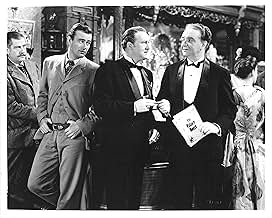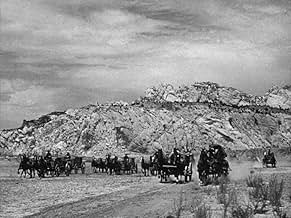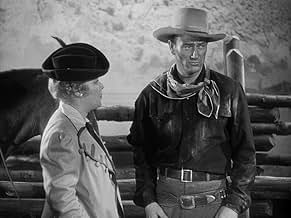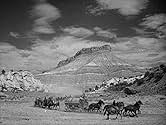NOTE IMDb
6,3/10
1,7 k
MA NOTE
Ajouter une intrigue dans votre langueIn 1906, on Oklahoma's Indian lands, a cowboy fights for oil lease rights against a greedy oilman while a pretty schoolteacher steals both men's hearts.In 1906, on Oklahoma's Indian lands, a cowboy fights for oil lease rights against a greedy oilman while a pretty schoolteacher steals both men's hearts.In 1906, on Oklahoma's Indian lands, a cowboy fights for oil lease rights against a greedy oilman while a pretty schoolteacher steals both men's hearts.
- Réalisation
- Scénario
- Casting principal
- Nommé pour 2 Oscars
- 2 nominations au total
Foncilla Adams
- Girl
- (non crédité)
Stanley Andrews
- Mason - Indian Agent
- (non crédité)
Charles Arnt
- Joe - Train Conductor
- (non crédité)
Avis à la une
In imdb, it's In old oklahoma.... roku has this as war of the wildcats 1943; the opening credits show wildcats. Stars john wayne, al dekker. When school teacher catherine allen heads west to really experience life, she bumps smack into wildcat oilman jim gardner and cowboy dan somers. Of course, they both chase after her. As well as oil rights. And what kind of a western would this be without gabby hayes? And dale evans in one of her earlier roles. It's silly and fun and moves right along. Better than your average western. Not dry and dusty like so many others. Directed by albert rogell. Nominated for best music and best sound.
This film is also very commonly known as "War of the Wildcats". As you watch it, the movie sure looks like a B--but with just a bit more polish, a bit longer running time and a bit more in the way of budget. This is because the film is sort of like a transitional film for Wayne. While he played in a ton of Bs during the 1930s, around 1939 (with "Stagecoach") he began playing in better and better films. But many of them looked a lot like Bs and felt a lot like Bs. His bigger budget studio projects were still a few years ahead.
The film begins with a feminist author (Martha Scott) leaving her tiny town. Apparently the local prudes were angry at her writing such a scandalous romance novel--and you get the impression that it really isn't THAT bad. In fact, it really can't be because Scott is a school teacher and never really lived a worldly life in this town. So, at the urging of the women, she is determined to see the world--and be more like one of her characters. But, she is conflicted and isn't quite sure where to go or what to do. Her dull old aunt wants her to live with her in Kansas City--but when she meets a big-time oil man (Albert Dekker), he convinces her to follow him to the oil fields and promises her wealth and excitement. There are two problems with this. First, Dekker is a bit of a pig and an ego-maniac. Second, John Wayne pops into her life--and back then he was a major hunk. And, since he was the star, it's not especially surprising where it all ends. In the middle portion of the film, Wayne and Dekker vie for power and fight over oil land that the Indians are willing to lease. But Dekker is determined not to play nicely--and seems willing to use some dirty tricks to make sure he alone gets these leases.
Overall, this is not an especially deep film nor is it very realistic. However, it is fun--and that is very important. Gabby Hayes and especially Marjorie Rambeau provide some fun support and color.
The film begins with a feminist author (Martha Scott) leaving her tiny town. Apparently the local prudes were angry at her writing such a scandalous romance novel--and you get the impression that it really isn't THAT bad. In fact, it really can't be because Scott is a school teacher and never really lived a worldly life in this town. So, at the urging of the women, she is determined to see the world--and be more like one of her characters. But, she is conflicted and isn't quite sure where to go or what to do. Her dull old aunt wants her to live with her in Kansas City--but when she meets a big-time oil man (Albert Dekker), he convinces her to follow him to the oil fields and promises her wealth and excitement. There are two problems with this. First, Dekker is a bit of a pig and an ego-maniac. Second, John Wayne pops into her life--and back then he was a major hunk. And, since he was the star, it's not especially surprising where it all ends. In the middle portion of the film, Wayne and Dekker vie for power and fight over oil land that the Indians are willing to lease. But Dekker is determined not to play nicely--and seems willing to use some dirty tricks to make sure he alone gets these leases.
Overall, this is not an especially deep film nor is it very realistic. However, it is fun--and that is very important. Gabby Hayes and especially Marjorie Rambeau provide some fun support and color.
Spanish American War Veteran John Wayne hitches a ride on oil magnate Albert Dekker's private railroad car just as he's putting the moves on traveling school teacher Martha Scott. That sets off a rivalry between them both professional and personal as Wayne gets under Dekker's skin.
Dekker's the big kahuna in Oklahoma territory which would soon be admitted under President Theodore Roosevelt to the union. He's crowding a lot of the small operators out of the field and they see in Wayne a leader and savior.
Later on when Wayne and Dekker compete with the rival proposals for leasing Indian oil lands they go to the White House where Dekker thinks he's got an inside track with the Interior Department. This leads to one of the three best scenes in the film. It turns out that the Duke served in the Rough Riders. The reunion of Wayne and Sidney Blackmer as Theodore Roosevelt is pretty good, who'd have thought Wayne would have had the ultimate inside track.
Dale Evans is in the film, she has a brief role as a saloon entertainer and sings a couple of period songs. She had not yet met her future husband Roy Rogers on the Republic lot, but in fact she was more the westerner than he in real life. He was from a rural Ohio town and she was from Uvalde, Texas. Dale also sang with Anson Weeks band before coming west both literally and figuratively.
Martha Scott is a good crinolined heroine wooed by both Wayne and Dekker. You will also see Grant Withers in one of his few roles in which he wasn't a villain.
Second best scene in the film, John Wayne emptying his pistol into Paul Fix who played one of Dekker's henchmen who actually goes a bit too far because of his personal hatred for Wayne.
Third best scene, the climatic rush to deliver oil by covered wagons and tankers when Dekker buys the pipeline to fulfill the contract. The normally parsimonious Republic studio and its boss Herbert J. Yates broke the piggy bank to stage this one in what was obviously their big budget film of the year. Still plays quite well today.
This is one of John Wayne's better films of the forties. He's given good production values in this western and a perfect role for him. Fans of the eternal Duke should not miss this one.
Dekker's the big kahuna in Oklahoma territory which would soon be admitted under President Theodore Roosevelt to the union. He's crowding a lot of the small operators out of the field and they see in Wayne a leader and savior.
Later on when Wayne and Dekker compete with the rival proposals for leasing Indian oil lands they go to the White House where Dekker thinks he's got an inside track with the Interior Department. This leads to one of the three best scenes in the film. It turns out that the Duke served in the Rough Riders. The reunion of Wayne and Sidney Blackmer as Theodore Roosevelt is pretty good, who'd have thought Wayne would have had the ultimate inside track.
Dale Evans is in the film, she has a brief role as a saloon entertainer and sings a couple of period songs. She had not yet met her future husband Roy Rogers on the Republic lot, but in fact she was more the westerner than he in real life. He was from a rural Ohio town and she was from Uvalde, Texas. Dale also sang with Anson Weeks band before coming west both literally and figuratively.
Martha Scott is a good crinolined heroine wooed by both Wayne and Dekker. You will also see Grant Withers in one of his few roles in which he wasn't a villain.
Second best scene in the film, John Wayne emptying his pistol into Paul Fix who played one of Dekker's henchmen who actually goes a bit too far because of his personal hatred for Wayne.
Third best scene, the climatic rush to deliver oil by covered wagons and tankers when Dekker buys the pipeline to fulfill the contract. The normally parsimonious Republic studio and its boss Herbert J. Yates broke the piggy bank to stage this one in what was obviously their big budget film of the year. Still plays quite well today.
This is one of John Wayne's better films of the forties. He's given good production values in this western and a perfect role for him. Fans of the eternal Duke should not miss this one.
This was Republic's most successful picture of 1943, offering solid if unspectacular entertainment.
It is a somewhat unusual western, being set in the early 20th century and featuring an antagonist (played by Albert Dekker) who is a ruthless businessman rather than the conventional evil villain. Dekker represents modernity and Wayne, of course, the more traditional hard moral man.
The two male leads compete for the heart of a romance writer played by Martha Scott, and for the oil rights of the Indian territory, with Wayne representing a much less predatory way of doing business.
Add some humor and lively action scenes and you get a quite enjoyable product, if a bit formulaic.
It is a somewhat unusual western, being set in the early 20th century and featuring an antagonist (played by Albert Dekker) who is a ruthless businessman rather than the conventional evil villain. Dekker represents modernity and Wayne, of course, the more traditional hard moral man.
The two male leads compete for the heart of a romance writer played by Martha Scott, and for the oil rights of the Indian territory, with Wayne representing a much less predatory way of doing business.
Add some humor and lively action scenes and you get a quite enjoyable product, if a bit formulaic.
A lesser entry in the John Wayne canon, but not without interest. I thought Duke did quite well with the light comedy in the first part of the film before getting tough later on. And he looks as good as he ever did.
I liked the opening scene as the camera panned along the train interior catching the comments of the passengers - including, I'm sure, Guinn "Big Boy" Williams who had a few words to say, though the film doesn't appear in his filmography on this site or in Quinlan.
Albert Dekker is quite a likable villain, and, for the era in which the film was made, it's quite clear what his intentions are towards Martha Scott; the innuendo is strong, and in the hotel she even looks into the room adjoining hers and gasps when she spots the bed where he wants her to end up.
I'm a bit dubious about the total oil capacity of the various wagons at the end of the film and how easily some of the explosions occurred, but the sequence is quite a novel one. And the period - very early 20th century - is an interesting one, with the film making several allusions to the new life-style that will be made possible by oil.
Apparently Rhonda Fleming is in the chorus line in her very first film, and Gabby Hayes isn't too annoying in his customary old coot/sidekick role.
I liked the opening scene as the camera panned along the train interior catching the comments of the passengers - including, I'm sure, Guinn "Big Boy" Williams who had a few words to say, though the film doesn't appear in his filmography on this site or in Quinlan.
Albert Dekker is quite a likable villain, and, for the era in which the film was made, it's quite clear what his intentions are towards Martha Scott; the innuendo is strong, and in the hotel she even looks into the room adjoining hers and gasps when she spots the bed where he wants her to end up.
I'm a bit dubious about the total oil capacity of the various wagons at the end of the film and how easily some of the explosions occurred, but the sequence is quite a novel one. And the period - very early 20th century - is an interesting one, with the film making several allusions to the new life-style that will be made possible by oil.
Apparently Rhonda Fleming is in the chorus line in her very first film, and Gabby Hayes isn't too annoying in his customary old coot/sidekick role.
Le saviez-vous
- AnecdotesSidney Blackmer made a career out of playing Teddy Roosevelt. He played him eight times in various film projects. 1-"This Is My Affair" (1937) 2-"The Monroe Doctrine" (1939) 3-"Teddy the Rough Rider" (1940) 4-"March On, America!" (1942) 5-"In Old Oklahoma" (1943), 6-"Bill "Buffalo Bill" (1944) 7-"My Girl Tisa" (1948) 8-"Never Kick a Man Upstairs" (TV Movie) (1953).
- Citations
Bessie Baxter: We've got a long way to go, and a short time to get there.
- ConnexionsEdited into Six Gun Theater: In Old Oklahoma (2021)
Meilleurs choix
Connectez-vous pour évaluer et suivre la liste de favoris afin de recevoir des recommandations personnalisées
- How long is In Old Oklahoma?Alimenté par Alexa
Détails
- Durée1 heure 42 minutes
- Couleur
- Rapport de forme
- 1.37 : 1
Contribuer à cette page
Suggérer une modification ou ajouter du contenu manquant


































